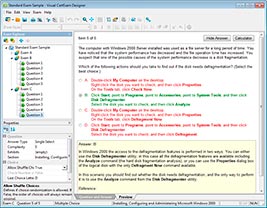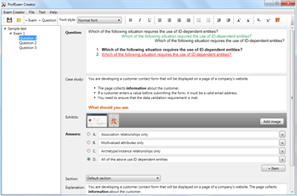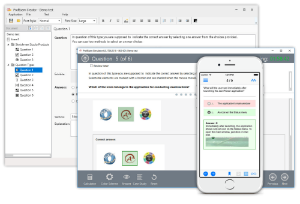Download Oracle Fusion Procurement Cloud Service 2016 Implementation Essentials.1z0-327.CertDumps.2017-12-27.83q.vcex
| Vendor: | Oracle |
| Exam Code: | 1z0-327 |
| Exam Name: | Oracle Fusion Procurement Cloud Service 2016 Implementation Essentials |
| Date: | Dec 27, 2017 |
| File Size: | 142 KB |
How to open VCEX files?
Files with VCEX extension can be opened by ProfExam Simulator.
Purchase
Coupon: TAURUSSIM_20OFF
Discount: 20%
Demo Questions
Question 1
While creating a Contract Purchase Agreement, a buyer tries to add a Contract Template to it, but the List of Values (VOL) is empty.
Identify three applicable reasons for this issue.
- The document type associated with the Contract Template is ‘Blanket Purchase Agreement’.
- The Contract Template is not ‘Approved’.
- The document type associated with the Contract Template is ‘Purchase Order’.
- The Contract Template is in ‘Approved’ status.
- The document type associated with the Contract Template is ‘Contract Purchase Agreement’.
Correct answer: CDE
Question 2
Your customer wants to configure three business units (BUs) as follows:
- US East BU and US West BU that perform requisitioning-related business processes and tasks. The US East BU provides payment services for its own invoices and for the US West BU’s invoices.
- One BU, US Header BU, that is configured as a shared Procurement BU with only the Procurement function enabled
Identify the correct configuration.
- The US Header BU needs to be configured as a Payables Payment Service Provider.
- The US West BU needs to be configured as a Customer Payments Service Provider.
- The US East BU and US West BU need to be configured as Payables Payment Service Provider.
- The US East BU needs to be configured as a Payables Payment Service Provider.
Correct answer: D
Question 3
Five requisition lines of a single requisition document are available to process on to purchase order. But the buyer returned one requisition line to the requester for quantity modification.
What will be the effect of this action on the remaining four requisition lines?
- They will be put on hold until the requester resubmits the returned line with the correct quantity.
- They will also get returned to the requester.
- They will be in the “withdrawn” status.
- They will be available to process on to purchase order.
- They will get canceled.
Correct answer: A
Explanation:
How can I reject individual items on a multi-item requisition? You cannot selectively approve or reject individual items. You can edit the requisition to add or delete items, modify requisition quantity, and then approve the requisition. If the approver needs to reject specific lines on the requisition, the approver should reject the entire requisition. The approver can include comments on the worklist task to highlight the rejection reason. The preparer then needs to update the requisition and resubmit it for approval. References: https://docs.oracle.com/cd/E56614_01/procurementop_gs/OAPRC/F1007478AN174A5.htm How can I reject individual items on a multi-item requisition?
You cannot selectively approve or reject individual items. You can edit the requisition to add or delete items, modify requisition quantity, and then approve the requisition. If the approver needs to reject specific lines on the requisition, the approver should reject the entire requisition. The approver can include comments on the worklist task to highlight the rejection reason. The preparer then needs to update the requisition and resubmit it for approval.
References: https://docs.oracle.com/cd/E56614_01/procurementop_gs/OAPRC/F1007478AN174A5.htm
Question 4
Identify two profile options that are required to configure Punchout Catalogs in Self Service Procurement.
- PO_DOC_BUILDER_DEFAULT_DOC_TYPE
- PO_DEFAULT_PRC_BU
- POR_DISPLAY_EMBEDDED_ANALYTICS
- POR_PROXY_SERVER_NAME
- POR_PROXY_SERVER_PORT
Correct answer: DE
Explanation:
POR_PROXY_SERVER_NAME and POR_PROXY_SERVER_PORT profile needs to be configured if Oracle is connecting to external or transparent punchout. POR_PROXY_SERVER_NAME and POR_PROXY_SERVER_PORT profile needs to be configured if Oracle is connecting to external or transparent punchout.
Question 5
During an implementation, the super user is requesting you to explain how to set up “risks” to be used in the Procurement Contracts by all users. You are in the middle of the year and currently there are few “risks” that are already defined and the organization is planning to introduce new “risks” from New Year’s Day.
Identify the two steps the user should follow to fulfill this requirement.
- Wait until year end, inactivate the old risks data on year end, and create and activate new risks from the same day.
- Provide an end date as year end for the old risk data, create new risks now, and provide New year’s Day as start date.
- Create new risks now, enable those at year end, and disable the old data on year end.
- The user needs to delete old risks and create new risks around the year end.
Correct answer: BD
Question 6
You have defined an attribute named ‘Years of Experience’ in your negotiation. You have set up scores for acceptable value ranges, and would like to rate responses based on this score. On getting the responses from the participating suppliers, you observe that for a few suppliers, the score was not calculated. Identify the reason for this issue.
- The Negotiation type is RFI (Request for Information); therefore, scoring is optional.
- The attribute ‘Years of Experience’ was not marked as Required, so the supplier did not provide any value.
- Sourcing does not support attribute definition.
- You already have a few suppliers defined in the system; therefore, the scoring did not take place.
Correct answer: B
Explanation:
Responses to Requirements can be scored according to the desirability of the response. You can define the Requirement such that the system automatically scores the response (in which case you must specify the allowable values (or ranges of values) for that requirement and each one's score. Or evaluators can view the response and enter a score manually. References: https://docs.oracle.com/cd/E26401_01/doc.122/e48968/T435340T443517.htm Responses to Requirements can be scored according to the desirability of the response. You can define the Requirement such that the system automatically scores the response (in which case you must specify the allowable values (or ranges of values) for that requirement and each one's score. Or evaluators can view the response and enter a score manually.
References: https://docs.oracle.com/cd/E26401_01/doc.122/e48968/T435340T443517.htm
Question 7
Name the Oracle Transactional Business Intelligence (OTBI) KPI that indicates the count of approved requisitions where at least one of the requisition lines is assigned to the new buyer who has logged in and that requisition line is not implemented into an order, bucketed by the number of days elapsed since the requisition was approved.
- Requisition Lines Cycle Time
- Requisition Aging Count
- Requisition Line Aging Count
- Requisition Lines Volume Count
- Requisition Lines in Process Count
Correct answer: E
Question 8
During the implementation, your customer wants to understand the key features of the two-stage Request For Quotation (RFQ) available in Oracle Sourcing Cloud.
Identify three features of the two-stage RFQ.
- Technical and Commercial Evaluation
- Open Auctions
- Two stage Evaluation
- Response Visibility Blind
- Response Visibility Open
- Response Visibility is always Sealed
Correct answer: ACF
Explanation:
The two-stage RFQ process involves the submission by the suppliers of a technical quote and a commercial quote. The technical quotes are opened and evaluated first to determine a list of qualified suppliers, and only then are the commercial quotes of the qualified suppliers opened and evaluated. TWO STAGE RFQ Ensure impartial judgment of supplier responses in markets that require technical and commercial evaluation of proposals to be done independently. While suppliers submit their responses as a single bid package, category managers first analyze the technical merits of the proposal while the commercial aspects of the bid remain sealed. Commercial details of bids that pass the technical evaluation are disclosed in the second evaluation phase, while the details of failed bids remain sealed. Category managers enter surrogate responses on behalf of suppliers by submitting the technical terms of the proposal during the first stage of the negotiation, and only entering the commercial terms if the first stage evaluation is successful. References: See What's Coming in Oracle Procurement Cloud (Release 9), page 8https://fusionhelp.oracle.com/helpPortal/topic/TopicId_P_EDADAB5CC7CF0747E040D30A68811553 The two-stage RFQ process involves the submission by the suppliers of a technical quote and a commercial quote. The technical quotes are opened and evaluated first to determine a list of qualified suppliers, and only then are the commercial quotes of the qualified suppliers opened and evaluated.
TWO STAGE RFQ
Ensure impartial judgment of supplier responses in markets that require technical and commercial evaluation of proposals to be done independently. While suppliers submit their responses as a single bid package, category managers first analyze the technical merits of the proposal while the commercial aspects of the bid remain sealed. Commercial details of bids that pass the technical evaluation are disclosed in the second evaluation phase, while the details of failed bids remain sealed. Category managers enter surrogate responses on behalf of suppliers by submitting the technical terms of the proposal during the first stage of the negotiation, and only entering the commercial terms if the first stage evaluation is successful.
References: See What's Coming in Oracle Procurement Cloud (Release 9), page 8
https://fusionhelp.oracle.com/helpPortal/topic/TopicId_P_EDADAB5CC7CF0747E040D30A68811553
Question 9
In a Procurement implementation, your customer has a requirement for a given business unit to enable “funds check” on purchase orders. This requires that budgetary control be enabled.
What configuration must you complete to enable budgetary control in that business unit?
- Enable budgetary control in both the Configure Requisition Business Function and Configure Procurement Business Function by selecting the business unit in scope.
- Enable budgetary control by selecting the business unit in scope using the task Configure Procurement and Payables Options.
- Enable budgetary control by selecting the business unit in scope using the task Configure Procurement Business Function.
- Enable budgetary control by selecting the ledger and business unit by using the task Manage Budgetary Control.
Correct answer: B
Question 10
While configuring offerings, you had deselected the “Supply Chain Financial Orchestration of Procurement Flows” check box and had locked the feature. However, because of changes in the business requirements, you are required to enable the feature.
Identify the prerequisite step to perform this change.
- Set the implementation status to “In Progress” of the Procurement Offering.
- Deselect the “Enable for Implementation” check box of the Procurement Offering.
- Change the Provisioned to “No” of the Procurement Offering.
- Navigate to the “Select Feature Choices” page of the Procurement Offering and unlock the feature.
Correct answer: B
Explanation:
If you used Inventory Management intercompany functionality prior to Release 9, then after your upgrade to Release 9, you must do the following to enable intercompany supply chain flows using Supply Chain Financial Orchestration:Identify profit center business units as Below Legal Entity Associate profit center business units with inventory organizations Enable the Supply Chain Financial Orchestration offering for implementation, and set the offering status to Implemented Select the Supply Chain Financial Orchestration of Procurement Flows feature in the Procurement offering Run the Verify Intercompany Flow Conversion scheduled process to confirm flow conversion Assign the Supply Chain Controller or Supply Chain Application Administrator job role to your implementation user References: Oracle Procurement Cloud Release 9 Whats New (5 May 2015), page 24 If you used Inventory Management intercompany functionality prior to Release 9, then after your upgrade to Release 9, you must do the following to enable intercompany supply chain flows using Supply Chain Financial Orchestration:
- Identify profit center business units as Below Legal Entity
- Associate profit center business units with inventory organizations
- Enable the Supply Chain Financial Orchestration offering for implementation, and set the offering status to Implemented
- Select the Supply Chain Financial Orchestration of Procurement Flows feature in the Procurement offering
- Run the Verify Intercompany Flow Conversion scheduled process to confirm flow conversion
- Assign the Supply Chain Controller or Supply Chain Application Administrator job role to your implementation user
References: Oracle Procurement Cloud Release 9 Whats New (5 May 2015), page 24
HOW TO OPEN VCE FILES
Use VCE Exam Simulator to open VCE files

HOW TO OPEN VCEX FILES
Use ProfExam Simulator to open VCEX files


ProfExam at a 20% markdown
You have the opportunity to purchase ProfExam at a 20% reduced price
Get Now!



